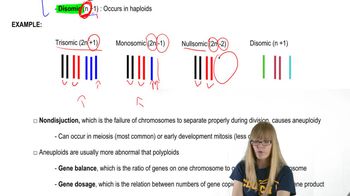Here are the essential concepts you must grasp in order to answer the question correctly.
Chromosomal Complement
The chromosomal complement refers to the complete set of chromosomes present in a cell. In humans, this typically includes 23 pairs, totaling 46 chromosomes. Each gamete, such as an oocyte, carries half of this complement, meaning it has 23 chromosomes. Understanding the chromosomal complement is crucial for assessing genetic balance and potential abnormalities in fertilization.
Recommended video:
Fluorescence In Situ Hybridization (FISH)
Fluorescence in situ hybridization (FISH) is a molecular cytogenetic technique used to detect and localize the presence or absence of specific DNA sequences on chromosomes. By using fluorescent probes that bind to specific chromosome regions, FISH allows researchers to visualize chromosomal abnormalities, such as aneuploidy, which is the presence of an abnormal number of chromosomes. This technique is particularly useful in reproductive genetics to assess the chromosomal status of oocytes.
Recommended video:
Aneuploidy and Its Consequences
Aneuploidy refers to the condition of having an abnormal number of chromosomes, which can lead to various genetic disorders. In the context of the question, if the secondary oocyte has two dyads of chromosome 21, it indicates a potential trisomy 21 condition (Down syndrome) in the resulting zygote if fertilized. This can result in developmental delays, physical growth issues, and increased risk of certain health problems, highlighting the importance of chromosomal balance in reproduction.
Recommended video:






